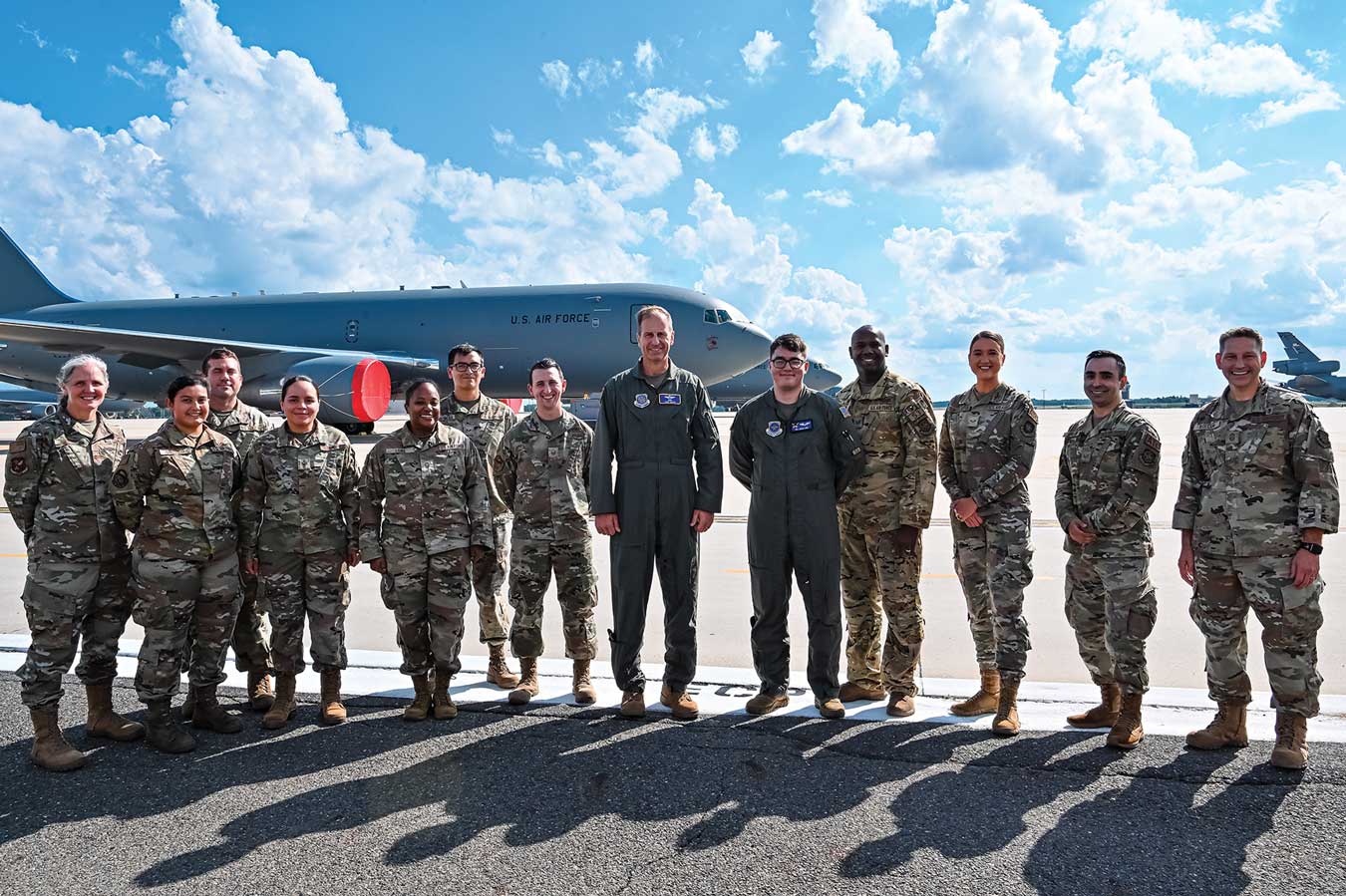Maj Gen Corey J. Martin of the 18th Air Force: Being Ready and Prepared
By MS. KATHY ALWARD, STAFF WRITER
Life can be interesting when we start out with one goal but learn through experiences that there may be a better path. Such is the case of Maj Gen Corey J. Martin, the Commander of the 18th Air Force headquartered at Scott Air Force Base, IL. Upon graduating from the Air Force Academy, he had planned to fly fighter aircraft, but according to Martin, once he entered pilot training, he was told that there were neither fighter nor bomber aircraft available as the Air Force was downsizing after the Cold War. Martin said that hearing about C-141s sounded like a good alternative, as they could fly formations at low altitudes, deliver people and equipment, and travel across the world. Martin found it interesting, a few years into flying the C-141, that the Air Force was actually looking for pilots in his year group to transition over to fighter aircraft. After thinking long and hard, Martin decided he was already where he was supposed to be, which led to him becoming a tactical expert in the C-141.
Martin’s squadron commander also encouraged him to take part in broadening opportunities that would lead to leadership roles. “One of them was a precursor to our current Phoenix Torch program,†said Martin. “And really coming out of that, I continued along both of those paths. As I went to new aircraft like the C-17, I would become a tactical expert, be an instructor, be an evaluator, but at the same time look for broadening opportunities like developmental education.â€
“As I look back now, I think that combination of having an opportunity to be an aircrew member and learn the capabilities of our aircraft, while at the same time having the opportunities in some of those command staffs to see the importance of how the aircraft are employed, has been a really good mix now that I’m sitting as the 18th Air Force Commander,†Martin explained.
The 18th Air Force is the Air Mobility Command’s (AMC) sole Numbered Air Force, and Martin says his duties as the 18th Air Force Commander are threefold. “First, and primarily, is ensuring ready aircraft, aircrew, and equipment for when combat commanders request them. The second one is the deliberate development of our Airmen, both to take on today’s challenges as well as tomorrow’s. And the final one is to discharge the general court-martial convening authority duties to maintain good order discipline,†stated Martin.
Martin oversees nearly 36,000 Airmen in the 18th Air Force, and fortunately, this is spread across 12 extremely capable wing commanders. “So I have 12 wing commanders that
are responsible for sections of the command that range from about 1,500 to about 6,000 personnel. And they are co-located with their personnel.…That’s what makes that span of control manageable,†he explained.
“Air Mobility Command is seldom in the spotlight itself, but I just find that it is foundational to almost everything that happens within, not just our Air Force, but our U.S. military,†Martin stated. Although they are not in the spotlight often, some of the high-profile operations executed can be attributed to the maneuvers that AMC provides. “When you see President Biden show up unannounced in Ukraine, well, how did he get there? It’s AMC. When you hear about humanitarian aid going where natural disasters strike, well, how does that happen? … Air Mobility played a role in that.â€
One of the many things Martin plans to accomplish is continually improving his command’s ability to operate if control networks are degraded or interrupted, which is going to be a reality of future conflict. “For probably three decades, Airmen have been used to having [the] ability to always be connected to command and control. We’re not going to have that anymore. So now what we’re focusing on is reintroducing that idea of independent thought, [from] deployed commanders down to actual aircraft commanders. [We] want for them to have the ability to take a commander’s intent and be able to take a mission-type order, not having exact guidance on where they’re going to fly next or what they have to do, and be able to have independent thought to do that on their own,†said Martin.
AMC has scheduled a tier one exercise for the summer, Mobility Guardian, which will take place in the Pacific, and according to Martin, will provide numerous opportunities for his crew force to continue to operate on mission-type orders when separated from the global command and control. This platform will allow the 18th Air Force to further develop their agile combat employment, multicapable Airmen, specialized refueling, and many other types of cross-utilization training.
Martin has also benefited greatly from the lessons provided by the safety offices. According to him, it is a matter of how you can do the mission and do it as safely as possible, and risk management is what helps accomplish that. A recent issue with the pins in the KC-135’s vertical tail is a good example; Martin emphasized that they never doubted that the pins were strong enough, even though they were non-conformal. What they did not know without testing is how long that strength would last. Given the environment he and his crew were in, they gauged the likelihood of something happening and measured that occurrence against a consequence. In doing so, AMC made the decision to stand those aircraft down, making a risk-informed decision. Martin stressed that if the environment had changed—if they had entered into active conflict and known that they needed all of their tanker aircraft to defend America—they would have considered the risk of not having those airplanes able to fly, and that same risk management thought process would have probably led them to fly. Martin stated, “I think a structured risk management process is one of the best things that has come out of safety during my time in the Air Force.â€


